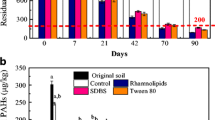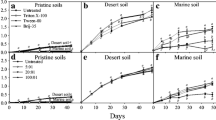Abstract
A series of experiments comprising microbiological testing, surfactant screening and microcosm systems are described for the preliminary development of a treatment for polychlorinated biphenyls (PCBs). Microbial isolates from contaminated soil and sludge and culture collections, were screened for degradation of a defined mixture of PCB congeners in liquid culture. Initially, one group of bacteria substantially degraded the dichloro-to pentachlorobiphenyls except where chlorinated at the 4,4′ position, but not hexachlorobiphenyl; whereas other microorganisms, includingPhanerochaete chrysosporium, showed greater degradation of the apparently more recalcitrant congeners. Repeated subculturing of the most promising bacteria on biphenyl supplemented media apparently increased their ability to degrade both the range and extent of congeners tested. The non-ionic Triton® X-100 and Tensoxid® S50 were the most effective surfactants at desorbing PCB from sand but had varying degrees of inhibition either to the growth, or alternatively to the PCB metabolism of the isolates tested. The greatest degree of PCB metabolism in the presence of Triton® X-100 was towards 2,3-dichlorobiphenyl, with a general reduction in the degree of degradation of trichlorinated to hexachlorinated congeners. The most effective reduction of Aroclor® 1242 in sand systems spiked with 1,000 mg/kg was achieved through a combination of inoculating biphenyl-degrading bacterial isolates together withPh. chrysosporium. This resulted in a reduction of approximately 40% in a 20-week period, although this was attributable largely to the removal of the less chlorinated rather than the more chlorinated congeners.
Similar content being viewed by others
References
Baxter RA, Gilbert RE, Lidgett RA, Mainprize JH, Vodden HA (1975) The degradation of PCBs by microorganisms. Environ 4:53–61
Bedard DL, Unterman R, Bopp LH, Brennan MJ, Haberl ML, Johnson C (1986) Rapid assay for screening and characterizing microorganisms for the ability to degrade PCBs. Appl Environ Microbiol 51:761–768
Bedard DL, Wagner RE, Brennan MJ, Haberl ML, Brown JF (1987) Extensive degradation of Aroclors and environmentally transformed PCBs byAtcaligenes eutrophus H850. Appl Environ Microbiol 53:1094–1102
Bewley RJF (1986) A microbiological strategy for the decontamination of polluted land. In: Assink JW, van den Brink WJ (eds) Contaminated Soil. Martinus Nijhoff Publishers, Dordrecht, pp 759–768
Bewley RJF, Theile P (1988) Decontamination of a coal gasification site through application of vanguard microorganisms. In: Wolf K, van den Brink WJ and Colon FJ (eds) Contaminated Soil '88, Kluwer Academic Publishers, Dordrecht, pp 739–743
Brown JF, Bedard DL, Brennan MJ, Carnahan JC, Feng H, Wagner RE (1987) Polychlorinated biphenyl dechlorination in aquatic sediments. Science 236:709–711
Brunner W, Sutherland FH, Focht DD (1985) Enhanced biodegradation of polychlorinated biphenyls in soils by analog enrichment and bacterial inoculation. J Environ Qual 14:324–328
Bumpus JA, Tien M, Wright DS, Aust SD (1985a) Biodegradation of environmental pollutants by the white-rot fungusPhanerochaete chrysosporium. In: US Environmental Protection Agency Incineration and Treatment of Hazardous Waste. Proceedings of 11th Annual Research Symposium, Cincinnati, OH, pp 120–126
—(1985b) Oxidation of persistent environmental pollutants by a white rot fungus. Science 228:1434–1436
Clark RR, Chian ESK, Griffin RA (1979) Degradation of PCBs by mixed microbial cultures. Appl Environ Microbiol 37:680–685
Digeronimo MJ, Nikaido M, Alexander M (1979) Utilization of chlorobenzoate by microbial populations in sewage. Appl Environ Microbiol 37:619–625
Eaton DC (1985) Mineralization of polychlorinated biphenyls byPhanerochaete chrysosporium, a lignolytic fungus. Enzyme Microb Technol 7:194–196
Eduljee G (1987) Volatility of TCDD and PCB from soil. Chemosphere 16:907–920
Fairbanks BC, O'Connor A, Smith SE (1987) Mineralization and volatilization of polychlorinated biphenyls in sludge-amended soils. J Environ Qual 16:18–25
Focht DD, Alexander M (1970) DDT metabolites and analogs: Ring fission byHydrogenomonas. Science 170:91–92
Furukawa K, Tonomura K, Kamibayashi A (1978a) Effect of chlorine substitution on the biodegradability of polychlorinated biphenyls. Appl Environ Microbiol 35:223–227
Furukawa K, Matusumara F, Tonomura K (1978b)Alcaligenes andAcinetobacter strains capable of degrading polychlorinated biphenyls. Agric Biol Chem 42:543–548
Furukawa K (1982) Microbial degradation of PCBs. In: Chakrabarty AM (ed) Biodegradation and detoxification of environmental pollutants. CRC Press, Boca Raton, FL
Hankin L, Sawhney BL (1984) Microbial degradation of polychloriaated biphenyls in sou. Soil Sci 137:401–407
Hutzinger O, Saye S and Zitko V (1974) The chemistry of PCBs. CRC Press, Boca Raton, FL
Lamar RT, Larsen MJ, Kirk TK, Glaser JA (1987) Effect of biotic and abiotic soil factors on the growth and degradative activity of the white-rot fungusPhanerochaete chrysosporium. In: American Chemical Society, preprints of papers presented at the 194th National Meeting, New Orleans, LA, August 30–September 4, 1987, p 621
Moza P, Weisgerber I and Klein W (1976) Fate of 2,2′-dichlorobiphenyl carbon 14 in carrots, sugar beets and soil under outdoor conditions. J Agric Food Chem 24:881–885
Quensen JF, Tiedje JM, Boyd SA (1988) Reductive dechlorination of polychlorinated biphenyls by anaerobic microorganisms from sediments. Science 242:752–754
Sayler GS, Shon M, Colwell RR (1977) Growth of an estuarinePseudomonas sp on polychlorinated biphenyl. Microb Ecol 3:241–255
Tucker ES, Saeger VW, Hicks O (1975) Activated sludge primary biodegradation of polychlorinated biphenyls. Bull Environ Contam Toxicol 14:705–712
Unterman R, Bedard DL, Bopp LH, Brennan MJ, Johnson C, Haberl ML (1985) Microbial degradation of polychlorinated biphenyls. In: United States Environmental Protection Agency Proceedings of International Conference on New Frontiers for Hazardous Waste Management, Cincinnati, OH, pp 481–488
Webb RG, McCall AC (1973) Quantitative PCB standards for electron gas capture chromatography. J Chem Sci 11:366–373
Author information
Authors and Affiliations
Rights and permissions
About this article
Cite this article
Viney, I., Bewley, R.J.F. Preliminary studies on the development of a microbiological treatment for polychlorinated biphenyls. Arch. Environ. Contam. Toxicol. 19, 789–796 (1990). https://doi.org/10.1007/BF01183994
Received:
Revised:
Issue Date:
DOI: https://doi.org/10.1007/BF01183994




